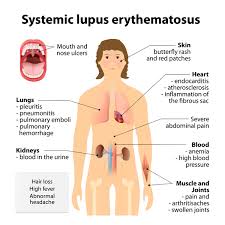Systemic Lupus Erythematosus(SLE) is a multisystem autoimmune disease with variable clinical behaviour.It may involve virtually any organ ,however,it principally affects kidney,skin,serosal membranes,joints and heart.

Diagnostic Criteria for SLE:
Because the clinical presentation of SLE is so variable with so many features resembling with other autoimmune diseases ,a criteria is made to develop a proper diagnosis.
11 CRITERIA
- Malar rash/Butterfly rash:(Fixed erythema,flat or raised,over the malar eminences,tending to spare the nasolabial folds.) when systemic lupus flares up, you may notice a sunburn-like rash on your face. This “butterfly” rash is a sign of acute cutaneous lupus (ACLE). The rash is distinctive for its butterfly-like appearance: It spreads across the nose and fans out on both cheeks. This rash can also emerge on other parts of the body, especially those exposed to the sun, such as the arms, legs, and trunk. The ACLE rash is very sensitive to light.

image:Butterfly rash - Disc shaped rash:(erythematous raised pathches with adherent keratotic scaling and follicular plugging.)In people with subacute cutaneous lupus (SCLE), the rash looks like scaly red patches or ring shapes. This rash usually appears on parts of the body that are exposed to sun, such as the arms, shoulders, neck, chest, and trunk. Having SCLE can make you more sensitive to the sun, so you need to be careful when going outside or sitting under fluorescent lights.
- Photosenstivity:rash occurring as an unusual reaction to sunlight.
- Oral ulcers

- Arthritis:(nonerosive arthritis.)Inflammation can cause pain, stiffness, and visible swelling in your joints, particularly in the morning. It may be mild at first and gradually become more obvious. Like other symptoms of lupus, joint problems can come and go.If over-the-counter (OTC) pain medications don’t help, see your doctor. There may be better treatment options. But your doctor must determine if your joint problems are caused by lupus or another condition, such as ARTHRITIS.
- Serositis :pleuritis,pericarditis.
- Renal disorders:persistant proteinuria >0.5g/dl >3+ if quantitation not performed.
- Neurological disorders: seizures,psychosis.Lupus often attacks the nerves, which carry messages from the brain to the rest of the body. This damage can lead to a range of symptoms, including:
- headaches
- confusion
- vision problems
- mood swings
- dizziness
- numbness
- Hematologic disorders: hemolytic anemia,leukopenia,lymphopenia,thrombocytopenia.
- Immunological disorders
- Antinuclear antibody

Mnemonic for SLE diagnostic criteria
The diagnosis is made if any 4 or more above mentioned features are present in an individual ,serially or simultaneously ,during any period of observation.






